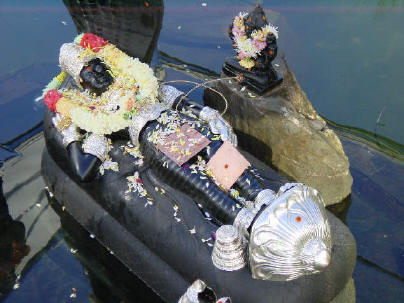Sri Rangam Temple in Wales
BY: SUN STAFF

Jan 4, USA (SUN) — [Revised] We were recently asked to share with Sun readers the story of an ISKCON devotee's travels to the Sri Rangam temple in Wales. The Sri Rangam Maha-Visnu murti there is said to have self-manifested, and the community developed around it. Gandhari devi dasi of Vancouver, BC, related these interesting details of her visit to Sri Rangam.
The Skanda Vale Monastery is also known as the 'Community of the Many Names of God'. The community was founded as a monastic centre in Wales in 1973, although the temple had been established 20 years previously in London. Skanda Vale comprises three separate Temples, one dedicated to Lord Subramanium (Lord Murugan), one dedicated to Maha Shakti, and one dedicated to Lord Ranganatha (Lord Vishnu).
Approximately 15 full-time devotees live on the property, ranging in age from youth to seniors. Many have taken vows of poverty, and dress in simple brown robes. The monks at Sri Rangam have been following St. Francis of Assisi. Their website explains, "Recognising the presence of God in all of creation, Skanda Vale is a sanctuary for all of life. The members of the Community look after a wide variety of birds and animals, including some unusual species such as an elephant named Valli."
The devotees at Sri Rangam have a great deal of faith in the Vedic mantras and chanting kirtan. Much time is spent performing Sankirtana, and arotiks are offered at three different temples on the property.
The temple does not charge a fee for admission. Visitors can stay there for free, with prasadam is provided at no cost. Everything is by donation. The devotees work with great faith in the mercy of the Lord, who sustains them and provides for maintenance of the 103 acre property.

Sri Maha-shakti
The temple grounds include facilities for a hospice care program. The devotees believe that chanting the Holy Names of the Lord is a sound vibration that can cure all negative effects of this age and change the mass consciousness of the entire planet.
The temple grounds are reported to be immaculately clean, and the devotees express a wonderful service mood, being hospitable to all the guests. The temple posts its rules and regulations, which ask visitors to have maintained a vegetarian diet for at least three days prior to arrival. No leather may be worn on the temple grounds.
The devotee who relayed the story of her travels compared the Sri Rangam community to our own Saranagati, saying that the hills, forests and small cabins are quite similar to the Saranagati environment. Hot water geysers and electric lighting are found on the property and for evening arotik to Lord Kartikeya, the temple hall was lit with dozens of four foot high ghee lamps.
Mangal arati for Lord Kartikeya is accompanied by gongs, bells and wompers. Many offers were made of bhoga, incense, flowers, cloths, etc., all piled in a huge heap in front of the altar. Chandan prasad was then distributed. Afterwards, a bus delivered the devotees up the hill for Kalkaji arotik, after which kumkum prasadam was distributed.
Next, guests were delivered back down the hill to the dining hall, where tables were overflowing with fruit, sweet rice and South Indian prasadam. The devotees were very carefully cleaning the plates, and exhorting everyone to not waste the prasadam.
One morning, the devotees were invited to attend a three hour abhisheka using kalashs of Panca-amrita. Continuous Visnu and Rama kirtan resounded, sounding like Purushasukta matras by the four pujaris. Abhisheka was performed for the seven foot tall murti of Sri Rangam, who is beautifully situated, lying in the middle of the pond. The pujaris stand on the center altar, with murti s of Laxmiji and Hanuman on one side, and Lord Brahma on His lotus from Lord Visnu's naval. All receive abhisheka twice each week. Other murtis include five foot tall devatas, Sri Ganesh, Lord Kartikeya, Lord Siva, Rudra, Saraswati, and Lord Krsna.
While abhisheka is going on, guests sit in comfortable chairs under a canopy, in a semi-circle around the pond. Curtains are arranged in the pond so they may be drawn while the Lord is being dressed and offerings are made. While the curtains are closed, a backdrop opens to reveal a beautiful lotus white murti of the Goddess Amba, who sits on her tiger in the pond. A pujari walks along a platform to offer her garlands and arotik. Afterwards, Lord Ranganatha and his entourage are ready to give darshan, being adorned with pure silver outfits, crowns, and paraphernalia, ready for Sundar arati. The scent of incense and camphor fills the air as devotees circumambulate the Deities.
For more information on Skanda Vale, please visit their website: Skanda Vale Monastary.
